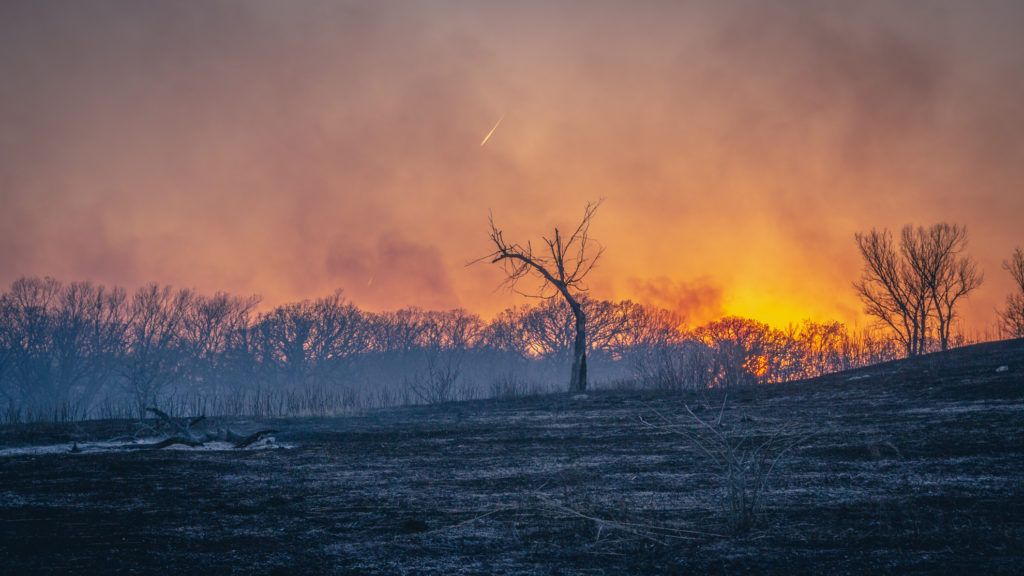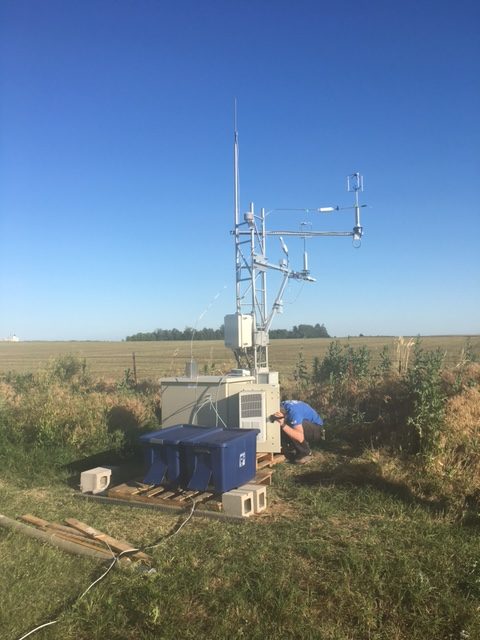Scientists Examine the Black Carbon Impacts of Wildfires and Biomass Burning
Published: 5 November 2020
Colorado State University teams use ARM data to help answer questions in earth system models

Researchers at Colorado State University (CSU) recently published two papers in the Proceedings of the National Academy of Sciences (PNAS) that address the deposition of aerosols and the effects of black carbon on ice nucleation.
Studying black carbon is important to scientists. In the atmosphere, it absorbs solar radiation, influences cloud formation, and affects cloud optical properties and temperature gradients. In the cryosphere, soot from black carbon deposition alters reflectivity and speeds melting on snow and ice surfaces.
Both studies were supported, in part, by the U.S. Department of Energy’s Atmospheric System Research (ASR) program. And for both, Delphine Farmer, a CSU chemistry associate professor, was one of the authors. Since 2011, she has led an aerosol research group at the university while serving as principal investigator for an ASR project, “Size-Resolved Particle and Black Carbon Deposition Over the Cryosphere.” Farmer has also been a principal investigator for campaigns managed by the Atmospheric Radiation Measurement (ARM) user facility.
Learn more about Farmer and the work of her research group in this September 2019 ASR profile.
Revising Climate Models With New Field Data
The following is based on a story by Katie Courage, CSU.
Smoke from the many wildfires burning in the western United States has made air quality hazardous for millions of people. It is the very tiniest of the aerosol particles in that air, making it particularly harmful to human health. But for decades, scientists have not known how long these particles stay aloft.
New research by CSU scientists is providing a much better understanding, which can help not only in air quality forecasting, but also in global climate modeling.
Aerosol particles, whether from wildfire smoke or car exhaust, play a large role in how much heat is absorbed or deflected by the atmosphere. However, scientists have not entirely understood how quickly these tiny particles were pulled out of the air—especially in the absence of moisture. This creates added uncertainty in already complex climate models.

Farmer and her colleagues, including associate professor Jeff Pierce, postdoctoral fellow Kelsey Bilsback, and recent graduate Anna Hodshire, recently announced that they have been able to detect, in real-world environments, the rate at which these important particles leave the atmosphere.
Their paper, published by PNAS in October, draws upon data from the Manitou Experimental Forest in Colorado and the 2017 Black Carbon Aerosol Deposition Study (BCADS) at ARM’s Southern Great Plains atmospheric observatory. Farmer was the principal investigator for BCADS.
The research group deployed an ultra-high-sensitivity aerosol spectrometer, which uses a laser to count particles and measure their diameters. The team set up measuring stations to capture real-world data on these particles as they drifted downward. “We measured how fast different particles run this gauntlet,” explains Farmer. “Then we used those measurements to figure out which part of the gauntlet slowed different particles down.”
Researchers found a much narrower range of lifetimes for these important particles than had been suggested by earlier modeling. In fact, the old predictions were counting on a faster removal of the very small particles (those less than 100 nanometers) and a slower removal of the larger particles (those greater than 400 nanometers).
“This means that we may have been underestimating the aerosol indirect effect in models,” says Farmer. “The good news is that we have been overestimating the uncertainty—we now know particle loss rates better.”
The new findings can be applied to all sorts of uneven surfaces, from forests to grasslands to agricultural areas, even to choppy seas.
When integrating their findings into models of the aerosol effects globally, Farmer and her co-authors predict the aerosol effect will be larger than previously assumed over certain land areas, including parts of North America, Europe, Asia, South America, Australia, and sub-Saharan Africa—and a lowering of the aerosol effect over oceans.
“It turns out that the particles’ race to settle on a surface is pretty important for predicting radiative effects” and what the future climate might look like, says Farmer.
Read the full story by Katie Courage on the CSU website: “Revising Climate Models with New CSU Field Data.”
Atmospheric Scientists Study Fires to Resolve Ice Question in Climate Models
The following is based on a story by Jayme DeLoss, CSU.
The extent of black carbon’s impact on clouds has been the subject of debate for 30 years. A CSU study first published in August by PNAS aims to settle the debate and improve climate models. ASR, NASA, and the National Science Foundation supported this work.

Previous studies in the laboratory conflicted on whether black carbon was effective at ice nucleation, a process important to cloud formation. Soot particles, like other types of aerosol particles in the air, can act as the foundations for ice crystal growth. Lab results on soot ranged wildly from no ice nucleation activity to efficient ice formation. The study also draws upon the 2015 ARM Cloud Aerosol Precipitation Experiment (ACAPEX), a ship- and air-based campaign that examined the role of dust in ice nucleation.
“One reason these results could span such a range is that combustion processes that form black carbon are extremely complicated and differ depending on fuels burned, and on whether combustion is carefully controlled, as in a diesel engine, or uncontrolled, as in wildfires,” says Gregory Schill, first author on the study and a former National Science Foundation postdoctoral research fellow.
Schill and his colleagues sampled smoke from wildfires and prescribed burns, then filtered out soot particles using a technique he developed with other members of Sonia Kreidenweis and Paul DeMott’s research group at CSU.
Researchers simulated the contributions of black carbon ice-nucleating particles versus other natural sources in a global model. They found black carbon is not as important as previously thought for ice particle formation in mid-level clouds, the clouds most responsible for precipitation over continents.
Natural sources, such as dust and sea spray, have more influence on mid-level cloud properties. These cloud attributes affect climate by reflecting sunlight, releasing precipitation, and determining how long the cloud persists.
“Our results suggest that black carbon, regardless of fuel types or combustion conditions, have similar ice formation properties in mid-level clouds, and these are less efficient at forming ice compared to other non-anthropogenic sources,” says Schill.
Read the full story by Jayme DeLoss on the CSU website: “CSU Atmospheric Scientists Study Fires to Resolve Ice Question in Climate Models.”
Keep up with the Atmospheric Observer
Updates on ARM news, events, and opportunities delivered to your inbox
ARM User Profile
ARM welcomes users from all institutions and nations. A free ARM user account is needed to access ARM data.


















